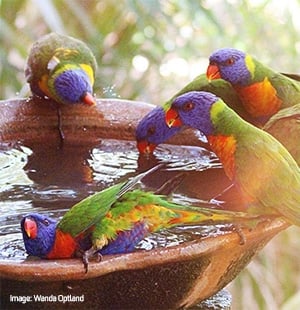Citizen scientists add to knowledge about bird behaviour
Research news
Deakin researchers have gained the biggest ever birds-eye view of Australian backyards, offering a fascinating insight into the variety, number and even size of avian wildlife drinking and washing in bird baths across the country.
Research Fellow with Deakin’s Centre for Integrative Ecology (CIE) within the School of Life and Environmental Sciences Dr Gráinne Cleary drew upon the observatory skills of more than 4,000 citizen scientists across Australia to find out what was going on in their backyard bird baths.
The project ran for a total of eight weeks over two parts in winter 2014 and summer 2015 and the resulting study, “Avian Assemblages at Bird Baths: A Comparison of Urban and Rural Bird Baths in Australia,” was published in the most recent edition of multidisciplinary science journal “PLOS ONE”.
“In a very dry continent like Australia, artificial water resources such as bird baths can be very important for birds, however nobody has looked at this aspect of human-wildlife interactions,” Dr Cleary says.
“Despite bird baths being a common addition to any wildlife-friendly garden, until now we knew nothing about the birds using them.
“We also collected information on how things like the presence of native plants, non-native plants and cats and dogs may influence what birds are visiting.”
Dr Cleary says the results of the citizen science study gave an otherwise impossible view of the nexus between urban life and wildlife, finding native birds were more partial to the backyards of our northern, warmer states, while the cooler climates of southern Australia attracted a greater share of introduced birds.
“Perhaps the introduced birds are more used to a cooler climate, meaning our southern states, including Victoria and Tasmania, feel more like home to them.
“And in the warmer regions, like Queensland and the Sydney Basin, the native aggressive honey eaters, such as Noisy Miners and Rainbow Lorikeets, thrived in backyards. So we are seeing a difference in birds using bird baths depending on where you live.”
She says it was a surprise to find a Goshawk drinking happily from a Sydney bird bath, and even more so when it was recorded drinking from it more than once.
“This shows that, somewhere along the line, even the predatory birds we’d normally associate with the far away world of the wild have become comfortable with human existence – so comfortable they are attracted to suburbia,” she says.
With such a large-scale project beyond the capacity of Dr Cleary and her research team including Drs Mike Weston, Kelly Miller and Darryl Jones, she relied on the goodwill of conservation groups and local government councils across the country to call out to willing participants within their communities.
Residents then recorded their observations of their backyards for 20 minutes, three times a week.
“We were really surprised with the level of interest right across Australia and so we then worked with the Atlas of Living Australia to customise an on-line database to collect semi-structured data from citizen scientists online,” Dr Cleary says.
“We then applied business intelligence data staging, transformation and data warehousing to provide analytical capacity to the researchers.
“In the past, data like this was collected by sending out paper surveys to people, but we were lucky to be able to combine the latest technology with ecology to collect our information.”
The research team has now begun work on the next stage of the project, the Australian Bird Feeding and Watering Study, a join initiative by Deakin and Griffith University, which will investigate the interactions people have with birds to understand the ecological and behavioural effects of bird feeding in Australian conditions.
“We will also collect data on the vegetation structure and composition of gardens as well as the presence of cats, dogs and even chickens,” Dr Cleary said.
She said it was important that citizen science results were publishable, as they could make an important contribution to both science and conservation, as evidenced by the bird bath study.
Share this story
 In a dry continent, artificial water resources like backyard bird baths can be important for birds.
In a dry continent, artificial water resources like backyard bird baths can be important for birds.
